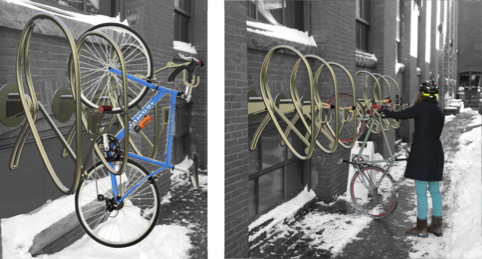The Massachusetts Institute of Technology’s (MIT’s) Center for Collective Intelligence created Climate CoLab as a place “where people work with experts and each other to create, analyze, and select detailed proposals for what to do about climate change.” Recent Climate CoLab contests asked participants to submit proposals on how to address climate change in several key areas.
The first two winners were reviewed in previous posts, “Creating the Right Climate for Green Learning at MIT” and “Bicycle Parking for a Healthier Planet“. Today, we announce the winner of “Fostering Climate Collaboration in Boulder, CO,” which answers the question, “How can we build community engagement and connectivity around climate change?”
A Greener Cafeteria Lunch
 The winning proposal from Kira Davis and Zoë Sigle won in both the Judges’ Choice and Popular Choice categories. The idea behind the proposal is to “drastically reduce GHGs” by promoting monthly Green Commons Luncheons, hosted by one climate conscious institution for other like-minded institutions. The luncheons would promote a plant-based diet while “fostering collaboration on climate research, mitigation, and advocacy,” claim Davis and Sigle.
The winning proposal from Kira Davis and Zoë Sigle won in both the Judges’ Choice and Popular Choice categories. The idea behind the proposal is to “drastically reduce GHGs” by promoting monthly Green Commons Luncheons, hosted by one climate conscious institution for other like-minded institutions. The luncheons would promote a plant-based diet while “fostering collaboration on climate research, mitigation, and advocacy,” claim Davis and Sigle.
Sustainability in Practice
 The proposal suggests that the food industry could be the next frontier for reducing our carbon footprint. By promoting local plant-based foods, and even creating partnerships with local farmers, these collaborative green lunches would reduce demand for less efficient food sources, such as methane-producing cattle. In essence, this is an opportunity for institutions promoting global sustainability to put into practice what they have preached all along.
The proposal suggests that the food industry could be the next frontier for reducing our carbon footprint. By promoting local plant-based foods, and even creating partnerships with local farmers, these collaborative green lunches would reduce demand for less efficient food sources, such as methane-producing cattle. In essence, this is an opportunity for institutions promoting global sustainability to put into practice what they have preached all along.
Winning the Bigger Contest
 This latest Climate CoLab contest winner adds one more piece to the collective puzzle in what MIT hopes will someday be a broader, all-encompassing climate solution. With 130,000 community members who can ultimately submit proposals addressing each climate challenge, Climate CoLab plans to bring the various contest winners together in one, cohesive, global climate solution.
This latest Climate CoLab contest winner adds one more piece to the collective puzzle in what MIT hopes will someday be a broader, all-encompassing climate solution. With 130,000 community members who can ultimately submit proposals addressing each climate challenge, Climate CoLab plans to bring the various contest winners together in one, cohesive, global climate solution.
For more about Climate CoLab, including how to join the community, visit the Climate CoLab website.


 The winning design, submitted by Julia Hanson, a former urban planning student, and Jeff Olinger, an architect, built on previous rack designs to address the specific conditions of Cambridge’s Kendall Square. The team’s
The winning design, submitted by Julia Hanson, a former urban planning student, and Jeff Olinger, an architect, built on previous rack designs to address the specific conditions of Cambridge’s Kendall Square. The team’s  The flycycle rack holds two bicycles on each frame in less space than the typical
The flycycle rack holds two bicycles on each frame in less space than the typical 
 The ultimate winners in the Climate CoLab series will be the inhabitants of our planet. Climate CoLab breaks down complex problems of climate change into smaller, more manageable ones, before asking its 130,000 community members to submit proposals. MIT plans to piece together the winning solutions to address the much broader issues impacting climate change. Anyone can join or participate in the process.
The ultimate winners in the Climate CoLab series will be the inhabitants of our planet. Climate CoLab breaks down complex problems of climate change into smaller, more manageable ones, before asking its 130,000 community members to submit proposals. MIT plans to piece together the winning solutions to address the much broader issues impacting climate change. Anyone can join or participate in the process. The project is spearheaded by MIT’s Center for Collective Intelligence and its
The project is spearheaded by MIT’s Center for Collective Intelligence and its  Winners will receive various prizes, including the opportunity to present their idea at MIT and be part of plans that could impact the U.S. and other countries worldwide. This year’s submissions are due Monday, May 23, and winners will be chosen for each of the 10 climate change challenges. There will also be a phase two of the contest where the winning proposals can be put together in various ways to form strategies for both individual nations and the world. All of the solutions will be evaluated by estimating how much
Winners will receive various prizes, including the opportunity to present their idea at MIT and be part of plans that could impact the U.S. and other countries worldwide. This year’s submissions are due Monday, May 23, and winners will be chosen for each of the 10 climate change challenges. There will also be a phase two of the contest where the winning proposals can be put together in various ways to form strategies for both individual nations and the world. All of the solutions will be evaluated by estimating how much  Part of this crowdsourcing approach includes welcoming comments from everyone around the world. Finalists were recently announced in three contests, on which you can now vote. Check out the ideas and cast your vote
Part of this crowdsourcing approach includes welcoming comments from everyone around the world. Finalists were recently announced in three contests, on which you can now vote. Check out the ideas and cast your vote  From “The Quickest Ever Slideshow on Global Warming” to fun facts, this colorful site is filled with engaging activities and information. To show kids how they can save energy every day, it features a typical kid’s bedroom with interactive stars on items (click on “You Can Make Big Changes”). When you click on different stars, a window opens up to show how you can save energy with that particular item. Another neat feature is a section for parents and teachers (click on any internal page to see the gray “Parents & Teachers” tab on the bottom of the right side of the page) where you can download games and activities.
From “The Quickest Ever Slideshow on Global Warming” to fun facts, this colorful site is filled with engaging activities and information. To show kids how they can save energy every day, it features a typical kid’s bedroom with interactive stars on items (click on “You Can Make Big Changes”). When you click on different stars, a window opens up to show how you can save energy with that particular item. Another neat feature is a section for parents and teachers (click on any internal page to see the gray “Parents & Teachers” tab on the bottom of the right side of the page) where you can download games and activities. This website from the U.S. Energy Information Administration also acts as a resource for teachers, providing a whole range of
This website from the U.S. Energy Information Administration also acts as a resource for teachers, providing a whole range of  The U.S. Environmental Protection Agency offers “A Student’s Guide to Global Climate Change” on this informative website. Kids are invited to go on
The U.S. Environmental Protection Agency offers “A Student’s Guide to Global Climate Change” on this informative website. Kids are invited to go on  Both economically and environmentally, the technology makes sense and can be replicated worldwide. Blake Boxley, Director of Environmental Health and Safety, Smithfield Hog Production, explains, “This project will show how farmers can do more than produce food. We can make energy, we can reduce waste, and we can be good stewards for our most important resources – land and water.”
Both economically and environmentally, the technology makes sense and can be replicated worldwide. Blake Boxley, Director of Environmental Health and Safety, Smithfield Hog Production, explains, “This project will show how farmers can do more than produce food. We can make energy, we can reduce waste, and we can be good stewards for our most important resources – land and water.” Yes, there is such a thing. Eighty-eight of them, in fact, at Smithfield Foods’ hog farms. Phase one of the $120 million project began back in 2014 by creating covers for these manure lagoons. The covers keep methane gas from escaping into the atmosphere, keep the rain out, and as you can imagine, greatly improve the way the air smells! Phase two is underway which involves technology that purifies the methane gas and then connects it to the natural gas pipeline. The project is on schedule to be completed this summer.
Yes, there is such a thing. Eighty-eight of them, in fact, at Smithfield Foods’ hog farms. Phase one of the $120 million project began back in 2014 by creating covers for these manure lagoons. The covers keep methane gas from escaping into the atmosphere, keep the rain out, and as you can imagine, greatly improve the way the air smells! Phase two is underway which involves technology that purifies the methane gas and then connects it to the natural gas pipeline. The project is on schedule to be completed this summer. Turning manure into energy isn’t the only transformation Roeslein Alternate Energy has in store for the Midwest. Future plans involve restoring prairie grasslands to produce prairie grass biomass that will also be converted into energy along with the manure. The prairie grass addition will double the project’s energy production and fund the transformation of marginal land into stretches of beautiful prairies filled with native wildlife.
Turning manure into energy isn’t the only transformation Roeslein Alternate Energy has in store for the Midwest. Future plans involve restoring prairie grasslands to produce prairie grass biomass that will also be converted into energy along with the manure. The prairie grass addition will double the project’s energy production and fund the transformation of marginal land into stretches of beautiful prairies filled with native wildlife. Experts say that to achieve this, fossil fuels will need to be eliminated in the later half of the 21st century. Otherwise massive droughts and flooding are just a few of the disastrous weather conditions future generations will have in store. To illustrate the point,
Experts say that to achieve this, fossil fuels will need to be eliminated in the later half of the 21st century. Otherwise massive droughts and flooding are just a few of the disastrous weather conditions future generations will have in store. To illustrate the point,  While the Paris Agreement is generally recognized as a defining moment in the climate crisis, it lacks certain key elements, such as how it will be enforced. At any rate, the next step is to get it ratified. This entails a few caveats. Each country must approve it within their own country. No less than 55 countries must approve it. And those 55 countries must be responsible for 55 percent of global CO2 emissions. That means it will most certainly need approval by China and the U.S. They are the largest polluters according to
While the Paris Agreement is generally recognized as a defining moment in the climate crisis, it lacks certain key elements, such as how it will be enforced. At any rate, the next step is to get it ratified. This entails a few caveats. Each country must approve it within their own country. No less than 55 countries must approve it. And those 55 countries must be responsible for 55 percent of global CO2 emissions. That means it will most certainly need approval by China and the U.S. They are the largest polluters according to